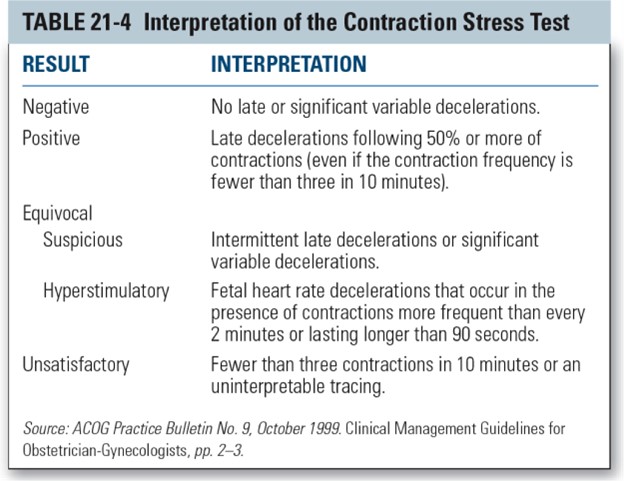A nurse is caring for a client who is undergoing an external nonstress test at 40 weeks of gestation and notes variable decelerations on the fetal monitor tracing that are unresponsive to interventions such as repositioning and oxygen administration.
Which of the following actions should the nurse take next?
Prepare the client for an amnioinfusion
Apply an internal fetal scalp electrode
Administer IV fluid bolus to the client
Discontinue oxytocin infusion if present
The Correct Answer is A
Prepare the client for an amnioinfusion. An amnioinfusion is a procedure that adds fluid to the uterus during labor to relieve cord compression and improve fetal condition. Variable decelerations on the fetal monitor tracing are a sign of cord compression and fetal distress. If repositioning and oxygen administration do not resolve the decelerations, an amnioinfusion may be indicated.
Choice B is wrong because applying an internal fetal scalp electrode does not address the cause of variable decelerations, which is cord compression.
An internal fetal scalp electrode is used to monitor the fetal heart rate more accurately, but it does not improve fetal oxygenation or prevent cord compression.
Choice C is wrong because administering IV fluid bolus to the client may help increase maternal blood volume and placental perfusion, but it does not directly increase amniotic fluid volume or relieve cord compression.
Choice D is wrong because discontinuing oxytocin infusion if present may reduce uterine contractions and decrease cord compression, but it may also prolong labor and increase the risk of infection or fetal compromise. Oxytocin infusion should only be discontinued if there are signs of uterine hyperstimulation or fetal intolerance.
Nursing Test Bank
Naxlex Comprehensive Predictor Exams
Related Questions
Correct Answer is B
Explanation
Negative CST.A negative CST means that there are no late or significant variable decelerations of the fetal heart rate (FHR) during three uterine contractions in 10 minutes.
This indicates that the fetus is well oxygenated and can tolerate the stress of labor contractions.
Choice A is wrong because a positive CST means that there are late decelerations of the FHR with 50% or more of the contractions.
This suggests that the fetus is at risk of hypoxia and may need early delivery.
Choice C is wrong because an unsatisfactory CST means that there are fewer than three contractions in 10 minutes or the tracing is not interpretable.
This does not provide enough information to assess the fetal well-being.
Choice D is wrong because an equivocal CST means that there are either intermittent late decelerations or significant variable decelerations.
This indicates that the fetus may have some degree of compromise and may need further testing.
Normal ranges for FHR are 110 to 160 beats per minute, and for uterine contractions are 2 to 5 per 10 minutes.

Correct Answer is B
Explanation
NST is less time-consuming and more comfortable than CST.This is because NST does not require any external stimulation of the uterus, while CST involves giving oxytocin to induce contractions.NST also does not pose any risk of preterm labor or fetal distress, which are possible complications of CST.
Choice A is wrong because NST does not provide more information about fetal status than CST.In fact, CST can detect fetal hypoxia more accurately than NST.
Choice C is wrong because NST does not have fewer contraindications than CST.Both tests have similar contraindications, such as placenta previa, multiple gestation, and previous cesarean section.
Choice D is wrong because NST does not have higher sensitivity and specificity than CST.
Sensitivity refers to the ability of a test to correctly identify positive cases, while specificity refers to the ability of a test to correctly identify negative cases.
NST has a high sensitivity but a low specificity, meaning it can detect most fetuses with hypoxia but also has many false positives.CST has a low sensitivity but a high specificity, meaning it can miss some fetuses with hypoxia but also has few false negatives.
Whether you are a student looking to ace your exams or a practicing nurse seeking to enhance your expertise , our nursing education contents will empower you with the confidence and competence to make a difference in the lives of patients and become a respected leader in the healthcare field.
Visit Naxlex, invest in your future and unlock endless possibilities with our unparalleled nursing education contents today
Report Wrong Answer on the Current Question
Do you disagree with the answer? If yes, what is your expected answer? Explain.
Kindly be descriptive with the issue you are facing.
